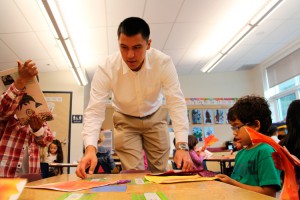
While 15 percent of the state’s population is Alaska Native, fewer than 5 percent of its teachers are.
To address this imbalance, the U.S. Department of Education and the University of Alaska Southeast have teamed up to create a scholarship program to groom future teachers and administrators while they’re still in college.
When children think about what they want to be when they grow up, many things would top the list above teacher. But there are exceptions.
Ronalda Cadiente-Brown says teaching can be really appealing to those of us who had good early experiences in education.
“I would venture to guess that if you asked anyone about their experiences in education … you would have an answer. As well as if you asked, ‘Who was your least favorite?’ you would have an answer. Everyone has that experience.”
Cadiente-Brown is the director of Preparing Indigenous Teachers & Administrators for Alaska Schools — or PITAAS. It’s part scholarship program, part support network for helping Native students find success training for a challenging career.
“Oftentimes if they’re coming from a rural area, they’re feeling the heartstrings to be home. Life goes on, and the challenges of dealing with tremendous loss and grief while they’re a student. I’ve seen students step away for a year to get their footing, and return back. So there are a lot of different pathways that are unique to any individual.”
PITAAS is funded by the U.S. Department of Education, but it’s a competitive program. Cadiente-Brown says she accepts about 10 students a year. Applicants have to have been in college for at least two years, with a 3.0 minimum grade-point average. Education majors, though, can enroll as freshmen. Some of her students are already in graduate school.
She says she’s seen a dramatic shift toward acceptance of cultural traditions, since when her mother was in school. Students no longer have to leave their cultural identities at the door.
“And our work today is really about helping to restore that identity. And colleges play a role in that as well. Look at some of the programming that’s available today. You have Native languages being taught in higher education, which is very different from washing it out of an individual.”
Cadiente-Brown was an assistant principal — and later principal — of Juneau’s alternative high school. Her transition to administration came after earning a master’s degree at Stanford. A Tlingit, she says she often encountered Native students who couldn’t quite wrap their heads around her success. Just her presence would turn around their expectations. And low expectations, she says, were rampant in our public schools.
“Probably the most criminal aspect that I saw was low expectations of Alaska Native students. And kids know it. When I worked with high school students they would again and again share that teachers just don’t care.”
Cadiente-Brown herself could have gone down a much different path. Her generation straddles the line between cultural barriers to success and the opportunity that programs like PITAAS now provide.
She says her own early circumstances shaped her decision to pursue an education.
“I come from a very large family myself. And some of my older siblings became teen parents — highly intelligent, very frustrated with formal education. And I’d have to say that they were some of my very early teachers, because I saw how they were struggling to make ends meet, raising families, that very early responsibility. And I always tell them I took the easy way: I stayed in school.”
Cadiente-Brown has been running PITAAS since 2011. Since the program’s inception 16 years ago, 271 students have received scholarships and 256 have received degrees. 50-percent of graduates come from rural parts of the state, and almost three-quarters are female.
